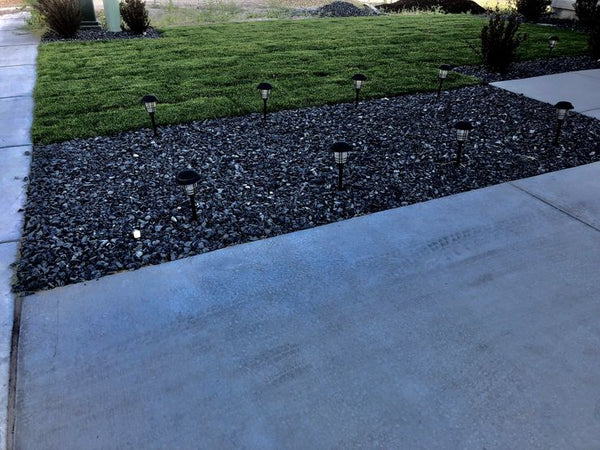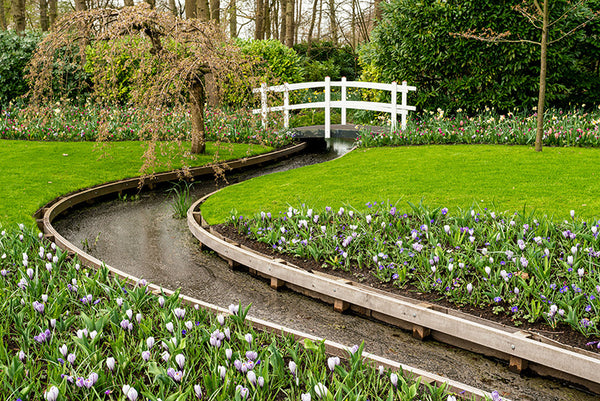Paver Patio or Flagstone Patio Install
Depending on the complexity of the project, this can be a weekend DIY project for the handy homeowner. If significant excavation or leveling needs to be done, it also could be a job best left up to the professionals. In the local Sandy, Utah a professional who has done some solid work in our area would be Beckstead Landscape.
What are pavers?
The term pavers typically refers to concrete paver blocks. They are typically purchased from distributors in the area. These could be resellers such as landscape supply centers or in some cases when manufacturers are in your area directly from the block manufacturer. In the Murray, Utah area where we are based out of you can find paver block suppliers such as Home Depot, Lowes, Beehive Brick, Sprinkler Supply, Asphalt Materials, Sunroc Building Materials, and probably many more. Typically they are sold in full pallet increments. Since these pieces butt directly up against one another they will have a specific number of square feet coverage that each pallet will cover.
What is Flagstone?
The term flagstone typically refers to sandstone slab pieces of rock which normally are between 1” and 3” thick, 1 ½” and 2” are very common. Because this is natural rock and thicknesses of the pieces may vary and the spacing between each piece can have different size gaps, the coverage per pallet may vary. Normally a supplier can give you a ballpark approximation of how many square feet a pallet will cover. These are also typically sold in full pallet increments but at times you may find that a supplier will sell them by the piece or broken down by the pound. Local suppliers near Herriman, Utah of Flagstone would be Asphalt Materials, Arrow Rock & Stone, Rockscapes, and many others.
How do you begin your patio project?
Pre Planning Stage
Determine what products that you will be using for the patio. Flagstone, Concrete Pavers, etc. How thick are the pieces? (This will come in handy when determining if any or how much excavation needs to happen). How many pallets will I need? (This will help you have an idea of the overall cost of the project materials). What sort of access do I have to the area? Are you limited by gate access or width or height restrictions due to other obstacles? (This is important as it may determine if you can use equipment to assist with the project or if its all hand work and possibly whether this job is best for a professional or if you feel comfortable tackling it as a DIY project).
Costs may vary so its best to price your materials based on what is available in your local area. Haul-4-U delivers bulk materials such as the Paverbase, Paversand, Roadbase, or Gravels as well as decorative rocks, mulches, River Rocks around the West Jordan, Utah area as well.
Step 1
Measure the area that you would like to cover.
This would be best performed with a tape measure and measuring the length and width of the area. But with technology of today, measuring can also be done using apps or other technological devices. The end goal is the same though and that is to establish the square footage that the patio will cover.
To determine the square footage (if the area is a rectangle) just multiply the length (in feet) x width (in feet). Example: 10 ft x 12 ft = 120 square feet.
Calculate necessary subgrade material and sand needed. Using the square footage of the area, determine cubic yards by adding in the depth. Square footage (in feet) x depth (in inches) divided by 12 = cubic feet.
Example: 120 square feet divided by 4 inches of depth = 120 / 4 = 30 cubic feet.
Cubic feet divided by 27 equals cubic yards. 30 / 27 =1.11 or round up to 1.25 cubic yards.
Its always best to calculate in a bit extra so that you don't run short. Materials being compacted such as paver base, road base, or paver sand might need additional amounts to account for the compaction. Typically no more than 15% - 25%
Step 2
Determine if any excavation or leveling of the area needs to be done to make the area level with a slope running away from the house.
Typically a slope of approximately 1% - 2% is sufficient, this means 1” per every 8ft of distance is enough to suffice. Having the subgrade slope away from the house will prevent water from flowing toward the foundation and potentially causing leaks later on.
How much excavation should be done?
This depends on what the ground is like where you plan on installing the patio. If it is grass or loose soil already, then it would be recommended that you remove 4” - 6” of material to install a stable compacted subgrade material such as either road base, paver base, or crushed aggregate (gravel). Then you will need a 1” - 2” layer of compactable sand (Paver Sand or Hardpack Sands work well in Utah and are commonly available in the Salt Lake area. Then on top of that you will have the thickness of either your pavers or your flagstone pieces. This could mean that you need to excavate up to 10” of material to place the patio on.
Now your area might not need that much excavation as your existing subgrade could already be compacted rocky granular borrow type material. You could also be coming out of a structure of concrete slab that steps down 4 - 6” already. So much of how much excavation needs to happen depends on what your site is currently like. Having a solid subgrade is key to the lasting longevity of the patio as if you place it on loose soil or not rocky subgrade, the patio could settle and shift with ground movement and become unlevel in the future.
Step 3
Clear the area, excavate or level and slope as needed.
Mark the area. This is often done with marking paint or with stakes and string lines. Then begin removal of the grass, dirt, and existing soil if needed. You will likely be using shovels and wheelbarrows or equipment such as a mini excavator or skid steer if you need to excavate a lot of material. But depending on your access and budget, equipment rentals might not be able to work for you. Remember the depth that you will need to have in order to make all the different layers of material go together.
Haul the materials to either another site nearby if you are keeping them on site, or make piles to load the material onto trucks or trailers for disposal. Disposal sites could be recycling facilities or landfills, or places accepting fill material as they are filling large areas.
Did you know that Haul-4-U can arrange pickup of products? We can drop trailers off for you to load with soil or if you have equipment on site to load with, we can schedule a truck to show up and haul the material away. Feel free to contact us to inquire.

Step 4
Add Paver Base, Road Base, or Crushed Gravel layer
Spread the subgrade base material throughout the project. In many cases you will only need about 4” of a subgrade material for this. Areas with heavier items or traffic you may want to increase this to 6”. Use a landscape rake to help spread the material around while keeping the slope going away from the house. Approximately 1” per every 8ft of distance away from the structure. This material should be compacted. Paver base or Roadbase must be compacted. Recommended Compactor would be a vibrating plate compactor. Typically those can be rented from Home Depot or Lowes, or Equipment Rental stores. You can compact using a hand tamper but you will get better compaction using a plate compactor which will lessen the chance of any settling the better the compaction is. As you compact the material (compact in approximately 3" layers or lifts for better compaction), lightly wet it as your run the compactor over it.
Step 5
Add the Paver Sand or Compactable Sand layer
If you used Paverbase or Roadbase as your subgrade, spread approximately 1” of sand across the entire area. If you used Crushed or Fractured Gravel as your subgrade, spread approximately 2” of sand over the entire area, sand will filter down between the gravel as you compact the sand layer which is why the gravel is recommended for approximately 2” of sand instead of the 1” with Paver Base and Road Base. Use the landscape rake to help spread the sand around. Then using the vibrating plate compactor of hand tamper, compact this sand layer as well.

Step 6
Lay out the Paver Stone or Flagstone pieces
Starting from 1 corner begin laying the paver stones or flagstone pieces. Remember that patio stones must butt up against each other, and flagstone pieces typically have about a ½” to 1” gap between the pieces. This gap can fluctuate depending on your desired look. As you lay each piece work with your level and make sure each piece goes in tight. You don’t want the pieces unlevel (accounting for the necessary slope still) or to be able to rock back and forth. Using additional paver sand level up each piece. Continue until all pieces are in place.

Step 7
Cut pieces as necessary
It is unlikely that the pieces will fit your area exactly and likely will have pavers or flagstone pieces which need to be cut. Using a masonry saw is the easiest way to perfect the cut. Be safe and use protective equipment when working with saws. Pieces may also be cut using a masonry blade for a grinder or a masonry blade on a chop saw. Flagstone pieces can often be broken using a chisel and hammer. Keep in mind that flagstone doesn’t always break exactly where you want. But you also have gaps between the pieces which allows for room for error.
Step 8
Place edging pieces in (if applicable).
This could be metal edging, edge paver stones, retaining wall blocks, flexible plastic edging, etc. There are many options here. These pieces typically get either buried partially in the ground or nailed in up against the patio pieces.
Step 9
Wash the area
Using a pressure washer or jet nozzle, wash and spray of the pavers or flagstone pieces to give them a nice clean appearance.

Step 10
Fill the joints
Filling the joints typically consists of using polymeric sand. This is a special type of sand which is blended with a dry glue. Usually is sold in bags and should be kept out of the weather until installation. Follow the instructions on the material for installation. Typically this involves spreading the sand over the surface and sweeping it into all the gaps. Then lightly misting with water and allowing a few minutes to begin initial setup. Then showering with a light spray of water allowing for enough water to get into all the sand to activate the glue and set the polymeric sand up.
Some people when laying flagstone may prefer to mortar their gaps rather than using a poly sand. Other people choose to fill their flagstone gaps with just the paver sand or soil or rocks. Some even plant moss in the gaps.

Step 11 (optional)
Seal the patio
Once the patio is completely installed and the gaps are filled, It's now time to seal the patio. You can use a concrete sealer or paver sealer to seal the patio. Typically these are applied by being sprayed on. But this will bring out the colors of the rocks and pavers and prevent them from getting as dirty from weather.
Your new patio is now ready to use.



